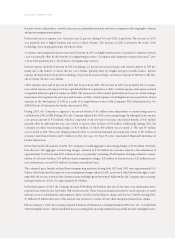American Express 2003 Annual Report Download - page 40
Download and view the complete annual report
Please find page 40 of the 2003 American Express annual report below. You can navigate through the pages in the report by either clicking on the pages listed below, or by using the keyword search tool below to find specific information within the annual report.
TRS is the primary asset generating business with significant assets in both domestic and international cardmember charge
card and lending activities. As such, the Company’s most significant borrowing and liquidity needs are associated with TRS’
card businesses. TRS pays merchants for card transactions and bills cardmembers accordingly. TRS funds merchant pay-
ments during the period cardmember loans and receivables are outstanding. AEFA’s borrowing needs are less significant as
it generates funds through its operations, primarily by the sale of insurance, annuity or certificate products. AEB also has
limited borrowing needs as its principal funding source is customer deposits. See the Liquidity and Capital Resources sec-
tion for TRS, AEFA and AEB for further discussion regarding each operating segment’s funding activities and liquidity man-
agement practices.
The following discussion includes information on both a GAAP and managed basis. The managed basis presentation
includes debt issued in connection with the Company’s lending securitization activities, which are off-balance sheet. The
Company’s management views and manages funding requirements on a managed basis because asset securitization is just
one of several ways for the Company to fund cardmember loans. Use of a managed basis presentation, including both on-
and off-balance sheet debt, avoids distortions due to the mix of funding sources at any particular point in time.
Funding Strategy
The Company’s funding sources are well diversified and include commercial paper, retail and institutional customer
deposits, bank notes, medium-term notes, senior debt, asset securitizations and other borrowed funds. Diversity of fund-
ing sources by debt instrument and by investor base provides additional insulation from unforeseen events in the short-
term debt market. The Company had the following consolidated debt on both a GAAP and managed basis and customer
deposits outstanding at December 31, 2003 and 2002:
(in billions) 2003 2002
Short-term debt $19.0 $21.1
Long-term debt 20.7 16.3
Total debt (GAAP basis) $39.7 $37.4
Off-balance sheet securitizations 19.5 17.2
Total debt (managed basis) $59.2 $54.6
Customer deposits $21.3 $18.3
In addition to deposits and debt, the Company uses off-balance sheet arrangements, principally through the sales of con-
sumer cardmember loans in securitizations. In 2003, the Company securitized $3.5 billion in loans from its consumer loans
portfolio. The Company had $19.4 billion of securitized cardmember loans as of December 31, 2003. Additionally, the Com-
pany had securitized cardmember charge card receivables of $3.0 billion at December 31, 2003, which remain on the Con-
solidated Balance Sheet.
(p.38_axp_ financial review)
























